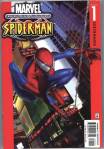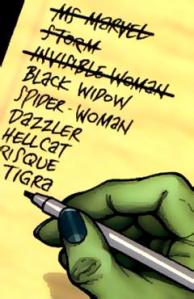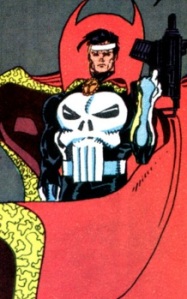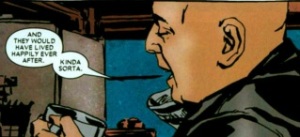Posts Tagged ‘Brian Michael Bendis’
It’s hard to write an original love story. How does one make the most universal of plotlines fresh and interesting? By re-telling his tortured relationship between his fundamentalist Christian upbringing and his first real love, Thompson gives us a unique twist on the autobiographical love story. Most of Thompson’s childhood and teenage years in small town Michigan are set during the harsh winter season. Thompson’s beautiful black and white drawings are a perfect complement to the stark, bleak beauty of his Midwestern hometown. Thompson has a big, sweeping lyrical style, but finest moments in Blankets are mostly silent. Like a silent film, Blankets’ strongest impact is in the images, such as the long dream sequence where the two lovers are mingled in the patchwork quilt Raina gives Craig.
What makes Blankets so compelling is Craig’s conflict between his deep-seated devotion to God and his passionate feelings for Raina. Religion rarely gets tackled in comics, and rarely as subtly as Thomson tackles it here. Without demonizing his former faith, he raises good, hard questions about his beliefs, and doesn’t give us any easy answers. What’s so refreshing is that Thompson leaves Craig’s relationship with Raina unresolved. When his relationship with Raina ends, it isn’t neat and tidy. Like real life, it’s messy and complicated, and sometimes we never see that person again. You wait to see if he’s going to circle back to Raina, and tell the reader what happened, but they are left hanging, just like in real life. Thompson spent five years on his 500+ page labor of love, and he leaves a moving testament to childhood, love and faith.
-Hava
14. Black Hole – Charles Burns
Set in 1970s Seattle, Black Hole is about the spread of a sexually transmitted disease that causes grotesque mutations in the teenagers who contract it. It’s also a horror comic, and Charles Burns’ tremendous work draws heavily in its aesthetic from the fantastically lurid grindhouse and slasher films of that era. But as you might expect, Black Hole is really just about growing up, and the physical transformations that the kids in the story go through only serve to literalize the genuine horrors of real-life adolescence. The sexual nature of their encounters and the complications that arise in their relationships reflect universal themes of immaturity, ignorance, shame, and alienation that pretty much all of us experience at that age. And, as with the high-schoolers in Black Hole, these are the trials that ultimately lead us to make the awkward transition into adulthood… or at least to just get the fuck out of town as soon as we’re able.
-Brendan
 13. Ultimate Spider-Man – Brian Michael Bendis
13. Ultimate Spider-Man – Brian Michael Bendis
If you’ve never read a Spider-Man comic before, what do you know about him? How does our impression of arguably the greatest character in the history of comic books differ between his official continuity and the cultural canon? It probably isn’t all alien symbiotes or organic web shooters versus mechanical or having six-arms or clones names Ben or the trials of marriage (let alone any “Brand New Days”) or the even Daily Bugle and getting his ass yelled at a lot for just trying to get on with his day.
Well, wait. Maybe that last one…
Spider-Man is beloved above and beyond all else for being the superhero we can relate to, the guy who’s life as Peter Parker was often as dramatically true to life as his costumed exploits were fantastic and, more importantly, were just as compelling and fun to read than the smash and bash, if not more so. So when the Ultimate Universe idea came around, it makes sense that Spidey was the most perfect fit for the update: Take all the stuff that we remember and love about Peter Parker’s history, and place it in a simple, modern context without all the decades of convolution. What you get is a 15 year old kid who has to deal with new powers (and new responsibilities) after he’s bitten by a radioactive spider… on top of dealing with high school. And it works. All the greatest moments get their due, and Brian Michael Bendis gives us as much meaningful time with Gwen Stacey, Mary Jane Watson, and the gang as he does thrills watching Pete quip one-liners as he puts the beats on the Green Goblin, Electro, and Doctor Octopus.
It works so perfectly that, like an awesome TV show that runs way too many seasons too long, it inevitably becomes just as convoluted as the series it was created to simplify, and actually had to be rebooted/relaunched itself! That’s comics for you. But for sixty-some issues, Bendis and series regular artist Mark Bagley delivered our friendly neighborhood web slinger as not as we know and love him, but as we felt like we knew and loved him. Which is really way better anyway.
-Brendan
12. Green Lantern: Rebirth – Geoff Johns
Love him or hate him, Geoff Johns was unarguably the continuity guru of the 2000’s, and his rise to prominence can be pinned on a single event: Green Lantern: Rebirth. Regardless of what critics have said of his work, Johns’ impact on the DCU was both immense and undeniable. First off, Johns brought Silver Age legend Hal Jordan back to life, reviving popular interest in the previously b-list Green Lantern Corps, spawning several on-going books, and a big-budget blockbuster movie. If that wasn’t enough, the success of this single story line managed to set the tone for DC continuity, landed Johns some of the best selling comic mini-series of his day, and poised him for a role as the head creative voice at DC Comics. Not too shabby.
-Maggie
DMZ’s portrait of a besieged Manhattan told through the lens of a semi-disaffected, semi-independent reporter is a book firing on all cylinders. Striking visuals evoke a place almost, but not entirely, unlike the New York City of today, and Brian Wood guides the reader through the morass of the city with the same ambivalence to the journalistic form as his lead character, Matty Roth. Whether you think Brian Wood glimpsed the future of the fragile Union, or if he’s just writing a different kind of the “real America,” cultural polarization hyperbole that has been the media’s stock-in-trade for the past few years, DMZ thrives so deeply in the ambiguity that it will keep even the most opinionated engaged. Not that this book lacks clarity of moral vision—there is good and there is evil—but they are rarely as clear as borders on a map.
-Darryl
- In: Fandom | Reviews & Booze
- 12 Comments
 There isn’t much going on at Marvel that I’m interested in right now, which isn’t terribly surprising. Marvel tends to be a boy’s club (said the female comic geek) and even though I’m sure Marvel Divas is fine if you’re into that sort of thing, I’ll start buying what Marvel markets to women when they can stop wrapping it in Pepto-Bismol pink. I like comics, ok Marvel? When you name a comic book “Divas” I half expect Celine Dion to show up. I’m not saying Divas is bad, I haven’t read it yet. For all I know, it’s the best book ever; but when comics are running $2.99+ an issue, I damn well do judge them by their covers. I don’t need a cutesy looking book, DO YOU HEAR ME JOE QUESADA? Just get some kick ass writers to write kick ass female characters and try not to call them Divas and wrap them up in SPECIAL FOR GIRLS TPB pink. Girls who LIKE comics are insulted, and girls who don’t like comics still aren’t going to buy them.
There isn’t much going on at Marvel that I’m interested in right now, which isn’t terribly surprising. Marvel tends to be a boy’s club (said the female comic geek) and even though I’m sure Marvel Divas is fine if you’re into that sort of thing, I’ll start buying what Marvel markets to women when they can stop wrapping it in Pepto-Bismol pink. I like comics, ok Marvel? When you name a comic book “Divas” I half expect Celine Dion to show up. I’m not saying Divas is bad, I haven’t read it yet. For all I know, it’s the best book ever; but when comics are running $2.99+ an issue, I damn well do judge them by their covers. I don’t need a cutesy looking book, DO YOU HEAR ME JOE QUESADA? Just get some kick ass writers to write kick ass female characters and try not to call them Divas and wrap them up in SPECIAL FOR GIRLS TPB pink. Girls who LIKE comics are insulted, and girls who don’t like comics still aren’t going to buy them.
That said, thank you for Spider-Woman. Thank you, thank you, thank you. I like Bendis (Ultimate Spider-Man is one of the four Marvel titles on my regular pull list, thankyouverymuch) so I picked up Spider-Woman last week. I know next to nothing about Jessica Drew, except that the Skrulls impersonated her and used her likeness to fuck a lot of shit up, but now the real Jessica is back. That’s it. That’s all I know. Well, other than the fact that along with Ms. Marvel, she’s one of only two women in the Marvel U carrying her own title right now.
 The only other female Marvel character I can think of who’s carried her own title in recent years is She-Hulk, and they keep shoving her into the Fantastic Four and the Lady Liberators. Oh, and cancelling her book. Most of Marvel’s female characters weren’t created to be standalone heroes, but to be part of a team. When a character is created to fill a specific role in a group, he or she is hard-pressed to carry a successful solo series. Wolverine is the exception that proves the rule, but come on, would you really buy a Cyclops solo book?
The only other female Marvel character I can think of who’s carried her own title in recent years is She-Hulk, and they keep shoving her into the Fantastic Four and the Lady Liberators. Oh, and cancelling her book. Most of Marvel’s female characters weren’t created to be standalone heroes, but to be part of a team. When a character is created to fill a specific role in a group, he or she is hard-pressed to carry a successful solo series. Wolverine is the exception that proves the rule, but come on, would you really buy a Cyclops solo book?
Jessica Drew might be able to carry a solo title longer than Jennifer Walters has ever managed to. She-Hulk’s never had much going for her. Seriously. There just aren’t that many places to take a watered down, big-boobied version of the Hulk. She-Hulk is completely derivative of the male Hulk which makes her one dimensional at best. Besides, the only time she actually seems to get used these days is in courtroom scenes anyway. Spider-Woman, on the other hand (name not withstanding), exists outside of Spider-Man continuity. Her powers are different from Peter Parker’s, her origin isn’t remotely related to his and she’s been screwed far more thoroughly than he has. Between the crazy scientist parents, the being raised in stasis, the HYDRA brainwashing, the Skrull invasion, Jessica is indeed the most screwed person in the universe. At this point she’s been screwed over just as hard, if not harder, than Wolverine – a comparison Bendis makes in issue one.
Bendis has proclaimed his love for the character a million times over; I love it when the powers-that-be give a good writer the chance to reboot a personally beloved character. Take a seasoned writer and let him have at the character he’s wanted to write for years and I guarantee you it’s going to be a blast to read. I never watched more than a preview of the motion comic version of Spider-Woman, and while I know this book was designed specifically for that format, I didn’t notice. Spider-Woman is dark, brooding, gritty and hot damn! Abby Brand shows up within the first ten pages, gives Jess a skrull detector and sends her off to Maripoor to wreck shit.
The Big Two have finally begun to put some serious effort into growing their female ranks. Rucka’s Batwoman should get her own title when Bruce gets back from the dead (sort of) and wants Detective Comics back, if she doesn’t get one it’ll be a crime. Abby Brand has become the female Nick Fury (Abigail Brand: Director of S.W.O.R.D. anyone? Close enough.) and if the first issue is any indication, Spider-Woman is going to be kicking ass for a while to come.
I drank a chilled glass of UV Pink Lemonade over ice with Spider-Woman. This is what happens when we start to run low on booze.

























